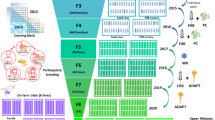Abstract
Triticale (Tcl) improvement concentrates on generating various crop and utilization options. These are associated with crop adaptive patterns, economic comparative advantages, issues of environmental sustainability, as well as issues of consumption, marketing, and end uses. By focusing on Tcl’s comparative advantages over other crops regarding these options, CIMMYT has shifted its Tcl breeding objectives. International yield data and past experience indicate high genetic progress in Tcl grain yield under marginal and high production conditions (> 1.5%/year). Since grain yield in marginal environments reflects the genotypic response to the total environment, progress has to be associated with advances for all biotic and abiotic factors involved. Under near optimal conditions, comparison in maximum yield trials at Cd. Obregon over three location years of Tcls developed in the 1980s and 1990s reveals overall yield progress to be at +17% due to increases in harvest index (+16%), grain biomass production rate (+21%), grains/m2 (+17%), spikes/m2 (+12%), and test weight (+12%) and a decrease in height (-11%). Genetic variabilities for these traits suggest that gains in genetic grain yield potential can be maintained in the future. High rates of progress in germplasm developed from crosses involving interspecific Tcl x wheat, spring x winter Tcl, and 2D(2R) x complete R type suggest that these gene pools are promising sources with which to achieve future genetic gains. The shift in breeding emphasis to complete R genome and 6D(6A) types in the 1980s was accompanied by improved test weights, but negative effects on baking quality. Subsequent research with wheat-Tcl grain and flour blends on milling and baking properties suggested blends for commercial use. In 1990, specialized requirements and markets for products for human consumption, feed grain, and growing interest in forage and dual purpose triticales were prompted by end-use oriented and expanded breeding objectives. By 1994, germplasm products for the range of utilizations are available. Current quality improvement hinges on introgressing high-molecular-weight glutenin subunits, particularly allelic variants at loci Glu-D1, Glu-B1 and Glu-Al. Spectacular increases in SDS sedimentation in 1D(1A), 1D(1B), and 1Rs.1Dl Tcls that carry D genome non-enzymatic storage proteins suggest a future breakthrough in improving Tel’s industrial quality, while additional gains can be expected from exploiting gliadins and secalins.
Early forage research in 1990 concentrated on determining the forage potential of STcl/FTcl compared with oats and barley as alternate forage commodities in one-cut situations. Results suggested that existing STcls were suitable for early forage, hay, and whole-crop silage. From 1991 onwards, a representative sample of the late STcl, FTcl, and WTcl gene pool was evaluated for forage potential in multiple forage harvests and grain-recovery potential [9]. Guided by results and implications, a new international nursery (FWTcl) was assembled including advanced and segregating FTcl and WTcl grain and forage materials and distributed to 75 cooperators. Parallel to the dissemination effort, traits such as reduced awns from different sources were identified, evaluated, and incorporated in the target gene pool.
Access this chapter
Tax calculation will be finalised at checkout
Purchases are for personal use only
Preview
Unable to display preview. Download preview PDF.
Similar content being viewed by others
References
Fox PN, Skovmand B, Thompson BIC, Braun HJ, Cormier R. Yield and adaptation of hexaploid spring triticale. Euphytica 1990; 47: 57–64.
Pfeiffer WH, Trethowan RM, Fox PN, Amaya A, Pena J, Cardenas F, Magana RI. The nineteenth international triticale yield nursery (ITYN). Results of the 1987–88 triticale nurseries. CIMMYT, Mexico, D.F., 1990.
Pfeiffer WH, Fox PN. Adaptation of triticale. In Proceedings, 2nd International Triticale Symposium, Passo Fundo, Rio Grande do Sul, Brazil, 1–5 Oct. 1990. 1991: 5459.
Pfeiffer WH, Alcalá M, Crossa J, Vega EH, Magaiia RI. The Twentieth International Triticale Yield Nursery (ITYN). El 20o Ensayo Internacional de Rendimiento de Triticale. The Twentieth International Triticale Screening Nursery (ITSN) El 20o Vivero Internacional de Seleccidn de Triticale. CIMMYT, Mexico, D.F., 1991.
Pfeiffer WH, Fox PN, Corbett J, Rodriguez MT, Magaiña RI. The twenty-first and twenty-second International Triticale Yield Nurseries (ITYN). El 210 y 22o Ensayos Internacionales de Rendimiento de Triticale. (ITYN). CIMMYT, Mexico, D.F., 1993.
Ortiz-Monasterio I, Sayre KD, Pfeiffer WH. Differences in nitrogen recovery among CIMMYT’s bread wheats and complete and 2D(2R) substituted triticales. Triticale Topics 1993; 11: 6–9.
Pfeiffer WH, Trethowan RM, Immonen AST, Amaya A, Peña RJ. Population parameters and their implications for applied breeding and projection of expected genetic advance in triticale. Proceedings, 2nd International Triticale Symposium, Passo Fundo, Rio Grande do Sul, Brazil, 1 Oct.-5 Oct. 1990. 1991: 121–124.
Pfeiffer WH. Triticale improvement strategies at CIMMYT: existing genetic variability and its implication to projected genetic advance. In Proceedings, 5th Portuguese Triticale Conference. Elvas, Portugal, 22 May-24 May, 1990 1994: in press.
Pfeiffer WH. Triticale improvement strategies at CIMMYT: exploiting adaptive patterns and end-use orientation. In Tanner DG, Mwangi W, editors. Proceedings, 7th Regional Wheat Workshop for Eastern, Central and Southern Africa, Nakuru, Kenya, 1992: 73–85.
Author information
Authors and Affiliations
Editor information
Editors and Affiliations
Rights and permissions
Copyright information
© 1996 Kluwer Academic Publishers
About this chapter
Cite this chapter
Pfeiffer, W.H. (1996). Triticale: Potential and Research Status of a Man-Made Cereal Crop. In: Guedes-Pinto, H., Darvey, N., Carnide, V.P. (eds) Triticale: Today and Tomorrow. Developments in Plant Breeding, vol 5. Springer, Dordrecht. https://doi.org/10.1007/978-94-009-0329-6_72
Download citation
DOI: https://doi.org/10.1007/978-94-009-0329-6_72
Publisher Name: Springer, Dordrecht
Print ISBN: 978-94-010-6634-1
Online ISBN: 978-94-009-0329-6
eBook Packages: Springer Book Archive




